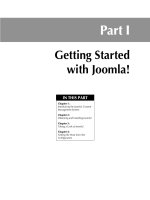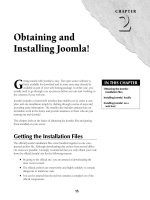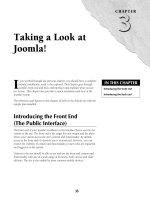Thiết kế web với joomla 1.6(5).x part 57 pptx
Bạn đang xem bản rút gọn của tài liệu. Xem và tải ngay bản đầy đủ của tài liệu tại đây (938.85 KB, 8 trang )
Part IV: Customizing and Extending the System
528
Tip
If you are new to working with CSS, there are a number of good resources online at the official Joomla! docu-
mentation site. A good place to start is here:
/>change_them
Controlling the Appearance of Menus
The Joomla! system provides menu styling options as part of the parameters for the menu mod-
ules. You can also style the menus through the use of the system’s CSS selectors. The following sec-
tion looks at the default styling options.
Cross-Reference
The creation of menus, menu items, and sub-menus is discussed further in Chapter 8.
The Joomla! system provides the administrator with the option to add class suffixes to a number of items
in the system. Page class suffixes, Module class suffixes, and Menu class suffixes are all examples of the
Class Suffix option in action. The purpose of all these options is the same, that is, to give you the oppor-
tunity to make the styling specific to that item by appending to the existing class the suffix of your
choice.
To take advantage of this feature you need to both specify the suffix for the item and then create the CSS
styling that goes with it. You have two options for setting the value of the suffix. First, if you simply type
a label into the provided class suffix field, the value will be appended directly to the existing class,
thereby removing the old class from application to the item and also creating a new class that you can
style. Alternatively, if you enter a space then type in the label, the system behaves differently: Instead of
replacing the old class with a new one, the system leaves the old class and adds a new class with the
same name as your label. Both the old class and the new class will be applied to the item.
By way of example, if the item was originally styled with a class named “moduleheading” and you add
the Module Class suffix “_blue” then the styling for the item would look like this: class=“moduleheading_
blue”. If instead you add the Module Class suffix “ blue” (that is, a space “ “ plus the word “blue”), the
code would be class=“moduleheading blue”.
The final step to complete the process would be to add the appropriate selector to your
template.
css
.
You can learn more about class suffixes at
/>Suffixes_in_Joomla!_1.5
Using class suffixes
Chapter 20: Customizing Joomla! Templates
529
Using the default options
As discussed in Chapter 17, Joomla’s menu modules provide basic control over the formatting of
the menus. The parameters for menu modules include four default menu styles. The selection of
the menu style has implications for the available CSS styling for the menu.
l
List: The default menu style. This style creates the menu as a plain unordered list <ul>,
where each Menu Item is a separate List Item <li>. This gives you the most flexibility for
controlling menu layout and allows for the use of tools like the Suckerfish menu system .
When this style is selected, the #menu id is applied to the <ul>.
l
Legacy - Vertical: This style is intended to create a style compatible with the old Joomla
1.0 vertical menu style. When this style is selected, the class .mainlevel is applied to each
link in a table. The table is set to 100% width (Note that using tables is generally frowned
upon in the CSS community. UL and LI tags are worth learning to style if you want your
web site to keep up with the latest standards.
l
Legacy - Horizontal: This style is intended to create a style compatible with the old
Joomla 1.0 horizontal menu style. When this style is selected, the class .mainlevel is
applied to each link in a table. The table is set to 100% width.
l
Legacy - Flat List: This style is intended to create a style compatible with the old Joomla
1.0 flat list menu style. This option is one option for creating horizontal menus, as seen in
the Top Menu on the default site with the sample data installed. When this style is
selected, the #menu id is applied to the <ul>.
The module’s Advanced Parameters also include options to create specific CSS selectors for the
menu and the ability to add a module class suffix or a menu class suffix.
Note
The use of Module Chrome can also make adding your own CSS styling to menus easy. See the discussion of
Module Chrome in the following section.
Creating drop-down menus
Joomla! does not support drop-down menu styles in the default system. The reason for this is
purely practical: Drop-down functionality has a number of variables, from placement to spacing to
drop-down style to how to handle multiple tiers. Drop-down menus invariably require a bit of tai-
loring to fit a particular template.
If you want to use drop-down menus, you need to consider either a template that includes drop-
downs, or a third party extension. If you want to use drop down menus with the default templates,
your best choice is the JA_Purity template, as it includes support for drop-down menus.
Part IV: Customizing and Extending the System
530
To convert the main menu in the JA_Purity template to a horizontal drop-down menu, follow
these steps:
1. Log in to the admin system.
2. Open the Module Manager by selecting the option Module Manager under the
Extensions menu. The Module Manager loads in your browser window.
3. Click on the name of the Main Menu Module. The Module Editing window opens.
4. Change the Position to hornav.
5. Change the Menu Style to List.
6. Set the Parameter Always show sub-nav items to Yes.
7. Delete any values in the Menu Class Suffix and the Module Class Suffix.
8. Click the Save button on the top-right toolbar. The changes are saved, the Module
Editing window closes and you are returned to the Module Manager.
Tip
You can also create drop-down menus with a number of third party extensions. One of the most common com-
binations is the Extended Menu Module combined with the Suckerfish drop-down. There is a good discussion
of this on the official Joomla! docs site at
/>Also note that you can style any type of UL using only CSS. Son of Suckerfish is one of the most commonly
used CSS drop-down menus. It can be found at
/>Cross-Reference
Chapter 22 includes reference to several third-party extensions that can enhance menu presentation.
Working with Module Chrome
Joomla! allows for control over the output of modules via either CSS or through the use of Module
Chrome. While CSS control is limited to what can be achieved through manipulation of the selec-
tors set in place in the module view, chrome opens up the possibility for you to define your own
styling. You have the option either to create your own custom styles or to use a default set of mod-
ule chrome styles.
The standard module chrome options are:
l
none: Raw output with no styling or formatting added and no module title output
l
table: Output the module in a table
Chapter 20: Customizing Joomla! Templates
531
l
horz: Output the module as a table wrapped inside a table (a nested table)
l
xhtml: Output the module wrapped in divs
l
rounded: Output the module in nested divs that support the use of rounded corners
l
outline: Output the module wrapped in the Module Position Preview wrapper
Note
For a breakdown of exactly what the effect of each of these has on the code output, please refer to these pages
on the Official Joomla! docs site:
and />chrome_CSS
The module chrome styles are defined inside the index.php file, by adding the style attribute
to the PHP includes that place the module position holders. By way of example, look at the follow-
ing lines of code, taken from the default RHUK_Milkyway template’s
index.php file:
<div id=”leftcolumn”>
<?php if($this->countModules(‘left’)) : ?>
<jdoc:include type=”modules” name=”left” style=”rounded” />
<?php endif; ?>
</div>
…
…
<td width=”170”>
<jdoc:include type=”modules” name=”right” style=”xhtml”/>
</td>
These two snippets show the default module chrome options in action. The first snippet shows the
jdoc:include statement with the style attribute set to “rounded.” The second shows the same attri-
bute set to “xhtml.” As a result of these attributes, all modules assigned to the Left position will use
the tags for the rounded style in their output. In contrast, all modules assigned to the Right posi-
tion will use the tags for the xhtml style in their output.
While the default styles add a great deal of flexibility there may be times when you need to achieve
even more specific styling. In those cases where you cannot get what you need from the default
module chrome styles, you can create your own custom module chrome.
To see custom module chrome in action, look at the default JA_Purity template. Note the following
lines of code from the JA_Purity
index.php file:
<div id=”ja-col2”>
<jdoc:include type=”modules” name=”right” style=”jarounded” />
</div>
Part IV: Customizing and Extending the System
532
The code uses the same syntax as above, but the style attribute is set to a custom value, in this case
“jarounded.” The value of jarounded is set by way of a function that is placed in the template’s
modules.php file. Here is the corresponding code from JA_Purity’s modules.php file:
function modChrome_jarounded($module, &$params, &$attribs)
{
<div class=”jamod module<?php echo $params->get(‘moduleclass_sfx’);
?>” id=”Mod<?php echo $module->id; ?>”>
<div>
<div>
<div>
<?php if ($module->showtitle != 0) : ?>
<?php
if(isset($_COOKIE[‘Mod’.$module->id])) $modhide = $_
COOKIE[‘Mod’.$module->id];
else $modhide = ‘show’;
?>
<h3 class=”<?php echo $modhide; ?>”><span><?php echo $module->title;
?></span></h3>
<?php endif; ?>
<div class=”jamod-content”><?php echo $module->content; ?></div>
</div>
</div>
</div>
</div>
}
This function enables the jarounded custom style for use in the template. Note how the code sets
out the formatting that will be used, calling the module output inside the div.jamod-content. The
function is a normal PHP function and can use any regular PHP code. The available module prop-
erties are determined by what properties that particular module possesses. In this example, the key
output properties used are:
$module->title and $module->content.
Note
It is also possible to specify custom attributes and parameters by way of the modules.php file. Module
parameters are accessed using the
$params object. Additional attributes require the creation of an
$attribs array. While these techniques are very powerful and add a great deal of flexibility, they also
require some fluency with PHP. Learn more at
/>To add custom module chrome to your template, follow these steps:
1. Create a new blank file. Name it modules.php and place it inside your template’s
/html directory.
Chapter 20: Customizing Joomla! Templates
533
2. Make sure the file has both an opening and closing PHP tag.
3. Add the following code at the top of the file, inside the opening tag: defined
(‘_JEXEC’) or die (‘Restricted access’).
4. Add the following to create your function. Substitute the name of your function for
the value STYLENAME in this example code:
function modChrome_STYLENAME( $module, &$params, &$attribs )
{
/* add the chrome for the Module output here
must include <?php echo $module->content; ?> to output the
content. */
}
5. Save the file.
6. Open the template’s index.php file.
7. For each module position where you want the custom chrome to appear, add the
attribute style=”STYLENAME” to the jdoc:include statements used to create the
module position holder, e.g.,
<jdoc:include type=”modules” name=”right”
style=”STYLENAME” />.
8. Save the file. The new module chrome appears, formatting the output of the modules in
the affected module position.
Overriding Pagination Formatting
Many Joomla! pages include pagination controls. These are the controls that allow the user to set
the number of items per page and to use links at the bottom of lists to navigate between pages or
items. Pagination overrides are kept in a dedicated file named
pagination.php and placed in
the
/html directory.
There are four functions available:
l
pagination_item_active: The links to the pages other than the current active page.
l
pagination_item_inactive: The current page that is active; typically this is not linked.
l
pagination_list_footer: Responsible for the output of the control setting the number of
items to display per page.
l
pagination_list_render: Controls the display of the list of links to the other pages,
including the Start, End, Previous, and Next links.
Part IV: Customizing and Extending the System
534
By way of example, look at the RHUK_Milkyway template. First, the template’s pagination.
php
file provides the following override for the formatting of the output control setting the num-
ber of items per page:
function pagination_list_footer($list)
{
$html = “<div class=\”list-footer\”>\n”;
$html .= “\n<div class=\”limit\”>”.JText::_(‘Display
Num’).$list[‘limitfield’].”</div>”;
$html .= $list[‘pageslinks’];
$html .= “\n<div class=\”counter\”>”.$list[‘pagescounter’].”</div>”;
$html .= “\n<input type=\”hidden\” name=\”limitstart\” value=\””.$lis
t[‘limitstart’].”\” />”;
$html .= “\n</div>”;
return $html;
}
Next, the template’s pagination.php file provides the following override for the formatting of
the links that appear at the bottom of pages:
function pagination_list_render($list)
{
// Initialize variables
$html = “<span class=\”pagination\”>”;
$html .= ‘<span>«</span>’.$list[‘start’][‘data’];
$html .= $list[‘previous’][‘data’];
foreach( $list[‘pages’] as $page )
{
if($page[‘data’][‘active’]) {
$html .= ‘<strong>’;
}
$html .= $page[‘data’];
if($page[‘data’][‘active’]) {
$html .= ‘</strong>’;
}
}
$html .= $list[‘next’][‘data’];
$html .= $list[‘end’][‘data’];
$html .= ‘<span>»</span>’;
$html .= “</span>”;
return $html;
}
Finally, the template’s pagination.php file provides the following overrides for handling the
formatting of the active and inactive page links that appear at the bottom of pages:
function pagination_item_active(&$item) {
return “<a href=\””.$item->link.”\” title=\””.$item-
>text.”\”>”.$item->text.”</a>”;
Chapter 20: Customizing Joomla! Templates
535
}
function pagination_item_inactive(&$item) {
return “<span>”.$item->text.”</span>”;
}
The most efficient way to add pagination overrides to your template is to copy the pagination.
php
file from either the default RHUK_Milkyway template or the default Beez template. Use that
code as your starting point. Save the copied code to your own
pagination.php file inside your
template’s
/html directory. Make any changes you need to your new file and you’re done. If there
is a
pagination.php file in the active template’s directory, the system will detect it automati-
cally and use it in preference to the default styling.
Creating a New Template
This section looks at the minimum requirements to set up a basic template. With these basics in
place, you have a solid foundation from which you can expand the template and introduce more
advanced features as needed.
Creating the structure
As a first step to creating your own template, you need to set up the necessary directory structure
and name properly the directories and files. By way of example, I am going to create a new Joomla!
1.5.x template named “Balinese.”
Follow these steps to get started:
1. Create a new directory inside /templates and name it /balinese.
2. Inside the /templates/balinese directory, create two new sub-directories: /css
and
/images.
3. Use your HTML editor to create the following empty files: index.php, template-
Details.xml
, template.css and component.php.
4. Place the files index.php, component.php and templateDetails.xml inside
/templates/balinese.
5. Place the file template.css inside the directory /templates/balinese/css.
With the steps above completed, you now have the structure in place to meet the minimum
requirements for a new template. The next step is to add the code to the files.
Creating the index.php file
The index.php file is responsible for placing all the output on the page. The code below sets all
the key elements in place, but without any styling; you can add the styling later with CSS.









